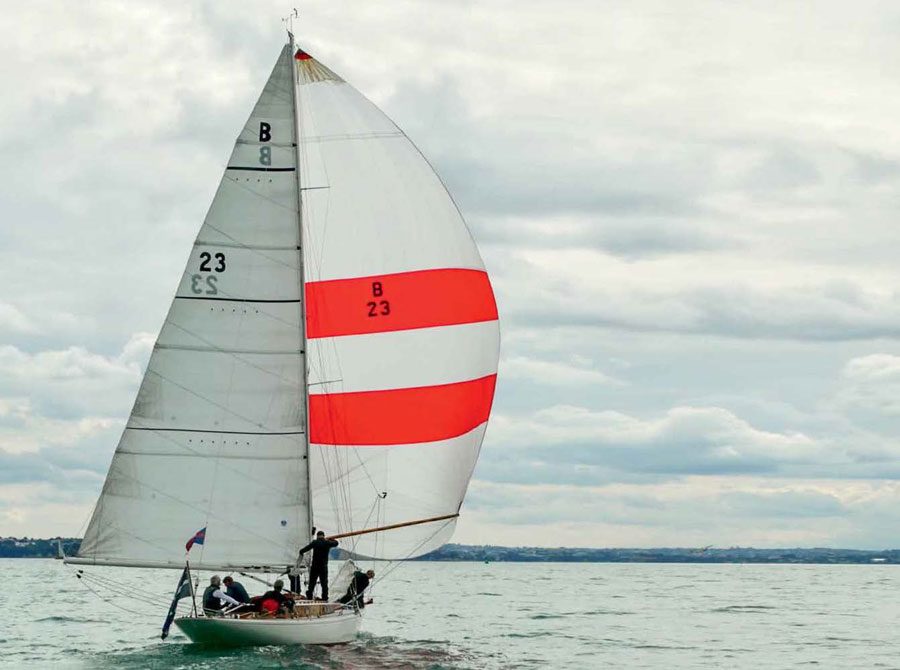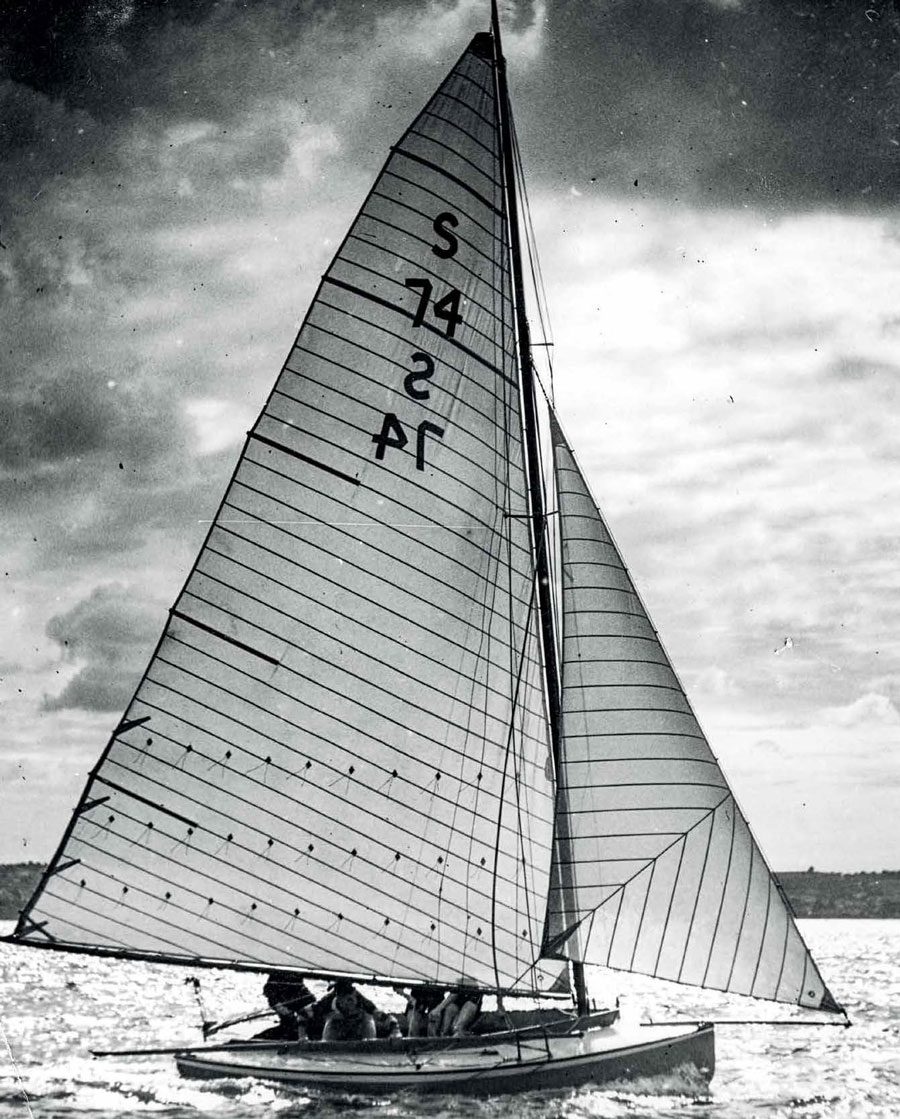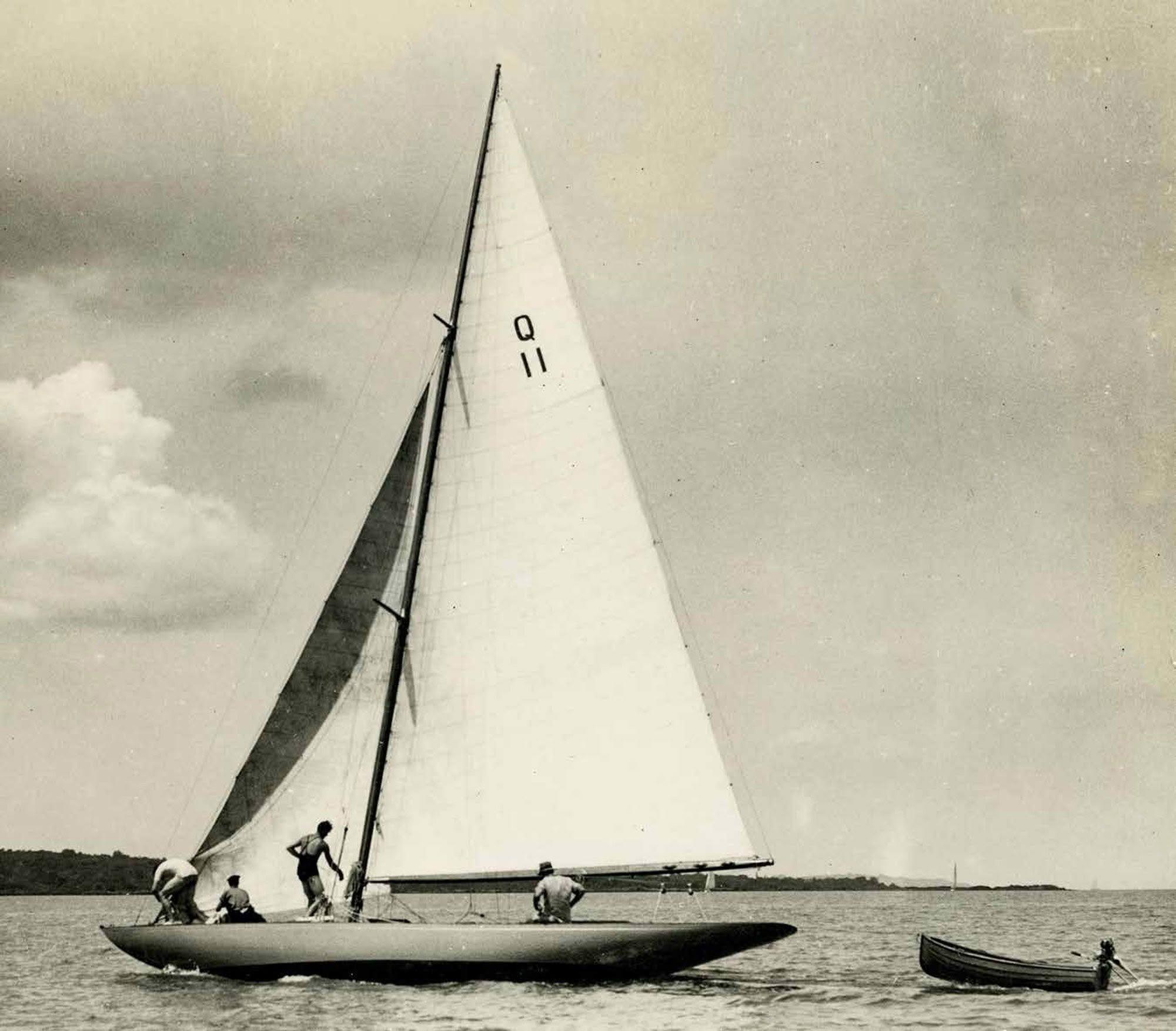

Although Arnold (Bill) Couldrey was producing some of the iconic yachts and launches of the period by 1937, he was by no means a wealthy man. Times were still hard although the Labour government, elected in a landslide in 1935, had lifted the economy and the spirits of the people out of the Depression that still crippled much of the rest of the world.
Bill Couldrey and his wife Gladys were living in a house he designed and built at 24 Richmond Road, Northcote, a property that had been owned by his uncle Hector George when he died aboard the keel yacht Victory while racing with Lady Jellicoe aboard in 1924. Their second son, Graham John Couldrey, was born on March 14, 1937. Bill continued to rent the yard on Sulphur Beach, Northcote, a few hundred metres away, from boat-builder Bob Brown’s widow.
As we saw last month, Bill launched the new-style Arthur C. Robb-designed keel yacht Tamatea in January 1937 for the Newcomb brothers. The remainder of 1937 he devoted to the construction of the superb launch Tiromoana with the centreboarders Mamaru and Sonoma to follow.

Once Tamatea was in the water, Bill started building the bridge-decker Tiromoana (sometimes misspelt Tirimoana) he had designed for a syndicate headed by W.R. Craig of Remuera. She was fitted with a 4LW Gardner diesel engine. She was a very pretty ship; every line was perfect, a high point of the bridgedecker style in this country to the time.
Craig’s syndicate sold Tiromoana to Henry Allen of Orakei in January 1940. She was allotted the number 785 to be painted on her bows for reporting at the harbour entrance. But Allen did not have long to enjoy her because of the severe fuel rationing now in force. In November 1941 the Navy took her over for patrol work with NAPS (Naval Auxiliary Patrol Service) but leased her to the Police for waterfront patrol on the Waitemata. After three years’ service in that role the Police returned her to Allen and replaced her with Pirate, a 41-footer built by Warne Bros in Russell in 1938 which had been seized from Otto Sommers of Russell, a German national, who was interned at Somes Island during the war.
Tiromoana stayed with Henry Allen for many years but moved on to Henry’s daughter Esme Coggan and her husband Reginald by the 1960s. The Allen family always cherished her and maintained her perfectly. They hauled her out every winter on her slip on the Tamaki River, two doors from the Lane Motor Boat Co, and gave her a fresh coat of paint. She stayed with the Coggans until 1992. These days she is often seen at Classic Yacht Club events, owned by John and Carolyn Caukwell, still looking beautiful and pristine.

After Tiromoana was out of the shed, Bill built two fast centre-boarders. For 19-year-old Norman Pollard, of the Henderson & Pollard sawmilling and joinery firm, he built the racing 18-footer Mamaru (V83) to the same design as Limerick. For the Gee brothers of Northcote he built the racing 16-footer Sonoma (S74) to replace their 16-footer Sirona (S8) designed and built for them by Vince Hogan in 1934.
Both centre-boarders were launched in November 1937. Both did well in the increasingly cut-throat 18-footer (V Class) and 16-footer (S Class) racing on the Waitemata. A distinct split had already developed in these classes between the racing and the cruising versions. The racing boats were increasingly light and highly rigged while the cruising versions tended to be more heavily built with raised foredecks and were referred to as ‘mullet boats’ or ‘mulletties’ when, technically, they were not…..but that’s a large subject, out of place in this article.
Although the fast 16-footers were very fast and welldesigned, they became eclipsed by the racing 18s, a trend that was about to be accelerated by the unexpected influence of the Australian 18-footer skiffs. In May 1937 the N.S.W. 18-footers Sailing League wrote to Arch Logan, the designer of Auckland’s refined 18ft M Class patikis. They sought his help in sending an Auckland 18ft representative to Sydney for their 150th Anniversary Regatta in January 1938.

Logan passed the invitation over to George Dennes of the Herne Bay Junior Yacht Club. By the time shipping schedules had to be met, other yacht clubs had joined in. Four of Auckland’s crack 18s, the M Class Manene, and the V Class Irina, Riptide (both designed and built by ‘Trot’ Willetts, and Va’alele (E. Hardman) made the trip. At stake was a brand-new prize, the ‘World’s 18-Footers Championship Trophy’, the brainchild of League secretary James J. Giltinan.
In the outcome, the Sydney skiff Taree, a new boat skippered by Bert Swinbourne, won the trophy. The radical Australian 18s proved vastly superior on their home water and easily dispatched the New Zealand yachts, which never threatened at any time. The only piece of silverware brought home was the rather spectacular Watson’s Bay Trophy, generously put up by the citizens of Watson’s Bay specifically for the visiting New Zealand boats and won by Bernie Schmidt sailing Riptide. It is still raced for today at Tamaki Yacht Club.
Amid the Anzac bonhomie and celebrations, the League promised a return visit to Auckland in 1939. In fact, this was New Zealand’s first international yachting event since the International 1-rater Championship on the Waitemata back in 1898. Auckland was in a state of heightened anticipation. 18-footer building was a priority. Bill Couldrey and his 18-footers were to play a large part in the events in 1939.

Bill now had a full order book for 1938. The major commission was the yacht Aramoana, but there were two fine launches. Tiromoana had been much admired around the waterfront, resulting in commissions to design and build two more high quality launches, Reremoana and Wairiki.
Aramoana was a thoroughbred, another Arch Logan design, this time for Norman Pollard’s older brother, 35-year-old Gordon Pollard, also of the Henderson & Pollard sawmilling firm. In the Logan fashion she was a three-skin diagonal-built 39’x26’x8’6”x5’6” Bermudan cutter with the sail number B23.
She was launched on October 15, 1938. Pollard’s first race was the Auckland-Tauranga Ocean Race starting at 7pm on December 23, 1938. Bill Couldrey’s Tamatea had won the 1937 race. Aramoana had a handicap of 2hrs 25min and came in second line and handicap, a brave first showing.
I digress, but one of my earliest memories is going aboard my father’s entrant in the race, Wakanui, at Mount Maunganui after my mother drove us down in our brand-new red Ford V8 pickup. I’m not sure which impressed me most, the yacht or the V8. Aramoana was moored just ahead in Pilot Bay.


Aramoana went on to have a Who’s Who of owners over subsequent years including W. M. McIndoe and G.R. Wilson 1953, Sir Keith Park 1958, Bert Waldron 1960, Dr. A. L. O’Dell 1965, Jim McGlashan and Jenni Seabrook 1985. She sails today in splendid condition, owned by Andy Ball.
Of the two launches, Reremoana was launched first, on November 2, 1938. A neat 28ft sedan built for leather goods manufacturer H.L. (Len) Ganderton of Sarsfield St., Herne Bay and fitted with a Kermath petrol engine. Then, in August 1939, just as war was about to break out, Ganderton commissioned Lane Motor Boat Co, then at Mechanics Bay, to extend her hull to 34ft 10ins and convert her to a bridge-decker configuration. She was re-engined with a 60hp Scripps.
Like many of the new or capable older launches in New Zealand, Reremoana was impressed in 1942 into patrol service with NAPS under Z12 with Charlie Lees, a close friend of Ganderton, as skipper. Cyril Parker bought her in 1953 and Colin Dennes had her in 1963, by which time she had a 90hp Redwing engine. Later owners included G.G.P. Taylor in 1970 and Dean Silich in 2001. These days, she remains in fine order.


Wairiki was a 30ft sedan built for dentist W.R. Ingram of Remuera with a 65hp Buda petrol engine. Ingram was a well-known yachtsman with a long history of owning interesting yachts and launches, most recently the Bailey & Lowe 38-footer Gispa, formerly Gladys, and the big Logan yachts Dawn, Ilex and Ethel. She was launched on December 19, 1938.
Colin Dennes of Herne Bay bought her after the war. She had been re-engined with a Chrysler. Colin was a prominent member of the Richmond Yacht Club and the Commodore of the Herne Bay Junior Yacht Club, the sponsor of the Silver Fern, the Arch Logan clinker 12-foot dinghy. Later owners included Norm Galbraith of Takapuna and Keith Peachey of Parnell, and owned for the last 20 years by Bill’s son Graham. Like Reremoana, she remains in great order. BNZ





